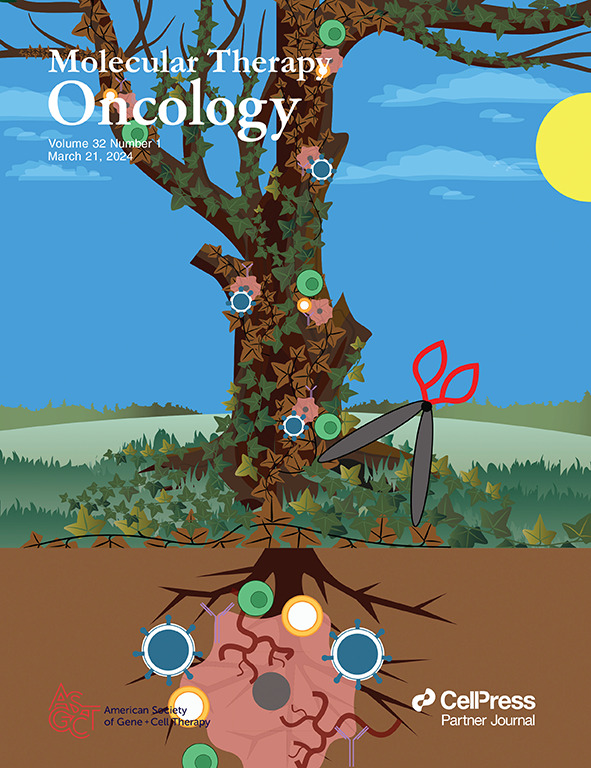Molecular Therapy Oncology: What’s in a name?
IF 5.3
2区 医学
Q1 MEDICINE, RESEARCH & EXPERIMENTAL
引用次数: 0
Abstract
In 2014, the American Society of Cell and Gene Therapy (ASGCT) launched a sibling journal to Molecular Therapy (MT), Molecular Therapy - Oncolytics (MTO), to accommodate the blossoming field of cancer biologics and publish studies that involved “engineering cells, viruses, or other microorganisms to combat cancer.”1Fong Y. MTO: a new journal for a maturing field.Mol. Ther. Oncolytics. 2014; 114001https://doi.org/10.1038/mto.2014.1Abstract Full Text Full Text PDF Scopus (0) Google Scholar Similar to the other MT sibling journals, MTO was intended to be an outlet for cancer therapy papers that deserved to be published but were more specialized and needed a more targeted audience. Their timing was right on, as it was concurrent with the first FDA approval of an anti-PD-1 antibody, and the following year, we saw the first FDA approval of an oncolytic virus as a cancer therapy.2First Oncolytic Viral Therapy for Melanoma.Cancer Discov. 2016; 6: 6https://doi.org/10.1158/2159-8290.CD-NB2015-158Crossref PubMed Scopus (34) Google Scholar Another 2 years thereafter, the FDA approved an engineered cell therapy for leukemia.3Bach P.B. Giralt S.A. Saltz L.B. FDA Approval of Tisagenlecleucel: Promise and Complexities of a $475 000 Cancer Drug.JAMA. 2017; 318: 1861-1862https://doi.org/10.1001/jama.2017.15218Crossref PubMed Scopus (123) Google Scholar Since then, checkpoint inhibitors have flourished, and cell therapies have exploded,4Mitra A. Barua A. Huang L. Ganguly S. Feng Q. He B. From bench to bedside: the history and progress of CAR T cell therapy.Front. Immunol. 2023; 141188049https://doi.org/10.3389/fimmu.2023.1188049Crossref Scopus (3) Google Scholar with six FDA-approved products so far and global markets estimated to reach $50 billion by 2030. Sadly, there has not yet been another oncolytic virus on the US market, though a few have received conditional approvals in other countries.5Zamecnik A. Immunotherapy insights: Oncolytic viruses struggle to find a spot in a crowded field.Pharm. Technol. 2023; https://www.pharmaceutical-technology.com/features/immunotherapy-insights-oncolytic-viruses-struggle-to-find-a-spot-in-a-crowded-field/Google Scholar Encouragingly, there have been promising clinical data reported in small studies in certain settings,6Desjardins A. Gromeier M. Herndon J.E. Beaubier N. Bolognesi D.P. Friedman A.H. Friedman H.S. McSherry F. Muscat A.M. Nair S. et al.Recurrent Glioblastoma Treated with Recombinant Poliovirus.N. Engl. J. Med. 2018; 379: 150-161https://doi.org/10.1056/NEJMoa1716435Crossref PubMed Scopus (486) Google Scholar,7Friedman G.K. Johnston J.M. Bag A.K. Bernstock J.D. Li R. Aban I. Kachurak K. Nan L. Kang K.-D. Totsch S. et al.Oncolytic HSV-1 G207 Immunovirotherapy for Pediatric High-Grade Gliomas.N. Engl. J. Med. 2021; 384: 1613-1622https://doi.org/10.1056/NEJMoa2024947Crossref PubMed Scopus (144) Google Scholar,8Gállego Pérez-Larraya J. Garcia-Moure M. Labiano S. Patiño-García A. Dobbs J. Gonzalez-Huarriz M. Zalacain M. Marrodan L. Martinez-Velez N. Puigdelloses M. et al.Oncolytic DNX-2401 Virus for Pediatric Diffuse Intrinsic Pontine Glioma.N. Engl. J. Med. 2022; 386: 2471-2481https://doi.org/10.1056/NEJMoa2202028Crossref PubMed Scopus (67) Google Scholar giving us hope there is a future for oncolytic viruses. No bacterial therapies have yet been approved, but there are numerous ongoing trials. Going by its title, MTO technically encompasses any therapy that destroys cancer (onco, from the Greek onkos, meaning lump or mass; lysis, from the Greek lusis, meaning breaking down). That said, in terms of everyday use, the term “oncolytics” is almost exclusively associated with oncolytic viruses and not really used to refer to any other type of therapeutic. The point was driven home to me as a newly minted editor-in-chief this year when a cell therapy author who had submitted a paper to MT refused to transfer it to MTO “because our study is not about oncolytic viruses.” Given all the exciting developments across a wide range of cancer therapy technologies in the decade since our launch, it is important we return to the original, broader vision of the ASGCT leadership and of the inaugural MTO editor-in-chief, Yuman Fong. To serve the field best, Dr. Fong emphasized that we need to publish “both basic and translational studies,” including relevant negative data (e.g., “no dose-limiting toxicity”), aiming “for rapid publication of new knowledge to facilitate treatment and cure of human cancer.”1Fong Y. MTO: a new journal for a maturing field.Mol. Ther. Oncolytics. 2014; 114001https://doi.org/10.1038/mto.2014.1Abstract Full Text Full Text PDF Scopus (0) Google Scholar Although it is only a switch of a few letters, we believe changing the journal name to Molecular Therapy Oncology will have a significant impact on the journal’s success, on ASGCT, and on investigators by making it clear we welcome submissions from all disciplines related to cancer therapy. You can find a description of our new scope on the MT Family’s Aims and Scope page.9Aims and Scope: Molecular Therapy Family of Journals: Cell Press.https://www.cell.com/molecular-therapy-family/aimsGoogle Scholar Furthermore, to provide expert management and review of a broader diversity of submissions, we plan to expand the expertise of our editorial board and our associate editors. Please check our website periodically for our call for volunteers to see the topic areas we seek to fill. It is an exciting time in cancer therapy, and with this journal rebranding, it is also an exciting time for Molecular Therapy Oncology.分子治疗肿瘤学:名字意味着什么?
2014年,美国细胞与基因治疗学会(ASGCT)推出了《分子治疗》(MT)的兄弟期刊《分子治疗-肿瘤学》(MTO),以适应蓬勃发展的癌症生物制剂领域,并发表涉及“工程细胞、病毒或其他微生物对抗癌症”的研究。[1]方勇。MTO:一个成熟领域的新期刊。其他。溶瘤。2014;114001https://doi.org/10.1038/mto.2014.1Abstract全文PDF Scopus (0) Google Scholar与其他MT兄弟期刊类似,MTO旨在成为癌症治疗论文的一个出口,这些论文值得发表,但更专业,需要更有针对性的受众。他们的时机很好,因为与此同时FDA批准了首个抗pd -1抗体,第二年,我们看到FDA批准了首个溶瘤病毒作为癌症治疗药物。第一个用于黑色素瘤的溶瘤病毒疗法。癌症发现杂志2016;6: 6https://doi.org/10.1158/2159-8290.CD-NB2015-158Crossref PubMed Scopus (34) Google Scholar又过了2年,FDA批准了一种用于白血病的工程细胞疗法。3Bach P.B. Giralt S.A. Saltz L.B. FDA批准Tisagenlecleucel:一种价值47.5万美元的抗癌药物的前景和复杂性。2017;[4]黄丽丽,冯强,何波,等。CAR - T细胞治疗的历史与进展:从实验到临床。前沿。Immunol。2023;141188049https://doi.org/10.3389/fimmu.2023.1188049Crossref Scopus (3) Google Scholar目前有6个fda批准的产品,预计到2030年全球市场将达到500亿美元。遗憾的是,美国市场上还没有出现另一种溶瘤病毒,尽管有一些病毒在其他国家获得了有条件的批准。5Zamecnik a .免疫疗法的见解:溶瘤病毒难以在拥挤的领域中找到一席之地。抛光工艺。2023;https://www.pharmaceutical-technology.com/features/immunotherapy-insights-oncolytic-viruses-struggle-to-find-a-spot-in-a-crowded-field/Google学者令人鼓舞的是,在某些环境下的小型研究中,有一些有希望的临床数据报告,6Desjardins A. Gromeier M. Herndon J.E. Beaubier N. Bolognesi D.P. Friedman A. h . Friedman H.S. McSherry F. Muscat A.M.重组脊髓灰质炎病毒治疗复发性胶质母细胞瘤。心血管病。医学杂志,2018;379: 150-161https://doi.org/10.1056/NEJMoa1716435Crossref PubMed Scopus (486) Google Scholar,7Friedman G.K. Johnston J.M. Bag A.K. Bernstock J.D. Li R. Aban I. Kachurak K. Nan L. Kang k.d。免疫病毒治疗小儿高级别胶质瘤的临床研究[j]。心血管病。医学杂志。2021;[14]李建军,李建军,李建军,等。脑桥神经胶质瘤的诊断与诊断[j] .中国医学信息学报,2013,31 (4):1313 - 1322 https://doi.org/10.1056/NEJMoa2024947Crossref PubMed Scopus (144) Google Scholar,8Gállego心血管病。医学杂志。2022;386: 2471-2481https://doi.org/10.1056/NEJMoa2202028Crossref PubMed Scopus (67) Google Scholar给了我们溶瘤病毒未来的希望。目前还没有细菌疗法被批准,但有许多正在进行的试验。顾名思义,MTO在技术上涵盖了任何消灭癌症的疗法(onco,来自希腊语onkos,意思是肿块或肿块;裂解,源自希腊语lusis,意思是分解)。也就是说,就日常使用而言,“溶瘤剂”一词几乎完全与溶瘤病毒有关,并不真正用于指代任何其他类型的治疗。作为今年新上任的总编辑,我明白了这一点,因为一位细胞治疗作者向MT提交了一篇论文,他拒绝将其转到MTO,“因为我们的研究不是关于溶瘤病毒的”。鉴于自成立以来的十年里,在广泛的癌症治疗技术领域取得了令人兴奋的发展,我们有必要回到ASGCT领导层和MTO首任总编辑方玉曼最初的、更广阔的愿景。为了更好地服务于这个领域,方博士强调,我们需要发表“基础研究和转化研究”,包括相关的负面数据(例如,“无剂量限制性毒性”),旨在“快速发表新知识,促进人类癌症的治疗和治愈”。[1]方勇。MTO:一个成熟领域的新期刊。其他。溶瘤。2014;虽然只是几个字母的切换,但我们相信将期刊名称更改为《分子治疗肿瘤学》将对期刊的成功、ASGCT和研究者产生重大影响,因为我们明确欢迎来自所有与癌症治疗相关学科的投稿。
本文章由计算机程序翻译,如有差异,请以英文原文为准。
求助全文
约1分钟内获得全文
求助全文
来源期刊

Molecular Therapy Oncolytics
Medicine-Oncology
CiteScore
10.90
自引率
3.50%
发文量
152
审稿时长
6 weeks
期刊介绍:
Molecular Therapy — Oncolytics is an international, online-only, open access journal focusing on the development and clinical testing of viral, cellular, and other biological therapies targeting cancer.
 求助内容:
求助内容: 应助结果提醒方式:
应助结果提醒方式:


